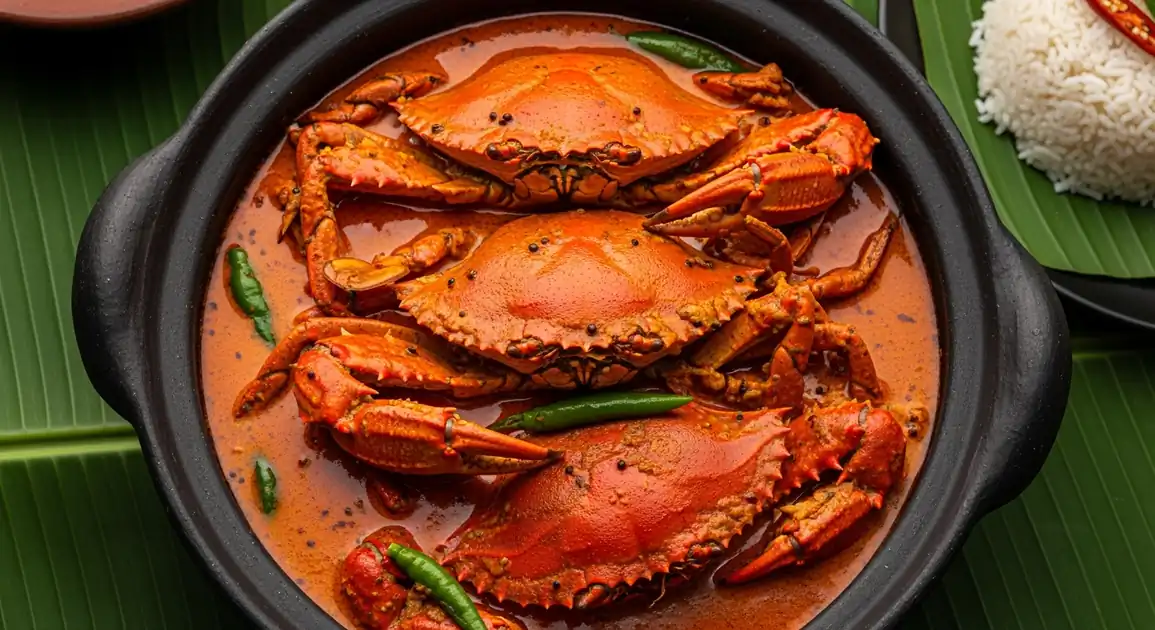Jaffna Crab Curry
யாழ்ப்பாண நண்டு கறி (Yāḻppāṇa Naṇṭu Kaṟi)

Description
In Colombo, Sri Lanka's cosmopolitan capital, Jaffna Crab Curry has evolved from a regional specialty to a prestigious dish served at establishments ranging from humble Tamil eateries to upscale seafood restaurants. The city's significant Tamil population maintains authentic versions, while innovative chefs offer contemporary interpretations that respect the dish's heritage.
Dietary Information
Serving information
Serving style
Upscale restaurants often serve dramatically in copper or clay pots with proper crab-eating tools. More casual establishments serve family-style in a central dish with rice. Most provide finger bowls with lemon water and extra napkins.
Quick facts
Lunch service typically runs 11 AM - 3 PM. Dinner service runs 6 PM - 10:30 PM, with seafood restaurants sometimes opening as early as 5 PM.
Safety Tips
What to Look For
-
Live crabs in tanks or very fresh seafood displays
The quality and safety of crab curry depends primarily on the freshness of the crabs. Restaurants with aquarium tanks or clear displays of iced fresh seafood typically use better quality ingredients.
-
High turnover of customers, especially locals
Busy restaurants serving many customers, particularly locals, usually have fresher ingredients and better food safety practices.
-
Clean kitchen areas if visible
If you can glimpse the kitchen, check for general cleanliness and proper food handling practices.
-
Proper storage practices for seafood
Fresh seafood should be stored on ice or in refrigerated displays, not at room temperature.
What to avoid
-
Strong ammonia or overly fishy smell
Fresh crab should smell mildly of the sea. A strong ammonia or overly fishy odor indicates spoilage.
-
Crab meat with yellowish discoloration
Fresh crab meat should be white to off-white. Yellowish coloration may indicate older crabs or improper storage.
-
Pre-cooked curry reheated for service
Quality Jaffna Crab Curry should be prepared fresh. Ask if the curry is made to order, especially in less busy establishments.
-
Restaurants with very few customers and seafood on the menu
Seafood requires quick turnover to maintain freshness. Empty seafood restaurants might use older ingredients.
Price information
Price range
Budget tips
- Small Tamil restaurants in Wellawatte and Bambalapitiya neighborhoods offer more affordable versions (1800-3000 LKR).
- Mid-range restaurants typically charge 3000-5000 LKR for a full portion.
- Upscale establishments like Ministry of Crab offer premium versions starting at 5000-8000+ LKR.
- Some places offer 'small' vs 'large' crab options, with significant price differences.
- Lunchtime set menus sometimes include crab curry at better prices than à la carte evening options.
Value indicators
- Size and weight of the crabs used (larger isn't always better - medium-sized lagoon crabs often have sweeter meat).
- Freshness (look for restaurants with visible crab tanks).
- Complexity of the curry gravy (should have visible spices and a layered flavor).
- Proper cooking technique (meat should be tender but not overcooked).
- Accompaniments provided (quality rice, coconut sambol, papadum, etc.).
Where to Find This Dish
Wellawatte
Known as 'Little Jaffna,' this neighborhood has several authentic Tamil restaurants serving traditional versions.
Wellawatte Market, Wellawatte Railway Station, New Saraswathi Lodge
Lunch, Dinner
Fort/Pettah Area
Historic center with some long-established restaurants serving good quality seafood.
Old Dutch Hospital Complex, Pettah Market
Lunch, Dinner
Mount Lavinia/Dehiwala
Coastal area with seafood restaurants offering fresh crab preparations.
Mount Lavinia Beach, Mount Lavinia Hotel
Evening
Galle Face/Kollupitiya
Upscale dining district with premium seafood restaurants.
Galle Face Green, Old Dutch Hospital Complex
Dinner
Vendor Tips
- Restaurants displaying live crabs typically serve the freshest dishes.
- Ask specifically for 'Jaffna style' preparation if you want the authentic version.
- Some restaurants will let you select your crab from the tank - choose active crabs with all limbs intact.
- Check if the restaurant is Tamil-owned or has chefs from Jaffna for more authentic preparations.
- Many places offer varying spice levels - specify if you want the authentic spicy version or a milder adaptation.
How to Order
Regional Variations
-
Ministry of Crab Style
(Ministry of Crab Naṇṭu Kaṟi)
The famous restaurant's interpretation features larger export-quality crabs with a slightly modified, often less intensely spicy gravy catering to international palates while maintaining authentic flavors.
-
Wellawatte Tamil Style
(Wellawatte Tamil Naṇṭu Kaṟi)
Restaurants in Colombo's Tamil district often serve the most authentic Jaffna-style version, with intense spicing and traditional preparation methods.
-
High-End Hotel Version
(Hōṭṭal Naṇṭu Kaṟi)
Luxury hotels often offer refined versions with elegant presentation and sometimes subtle fusion elements while maintaining core flavors.
-
Negombo Influence
(Negombo Pāṇi Naṇṭu Kaṟi)
Some Colombo restaurants serve a variant influenced by nearby Negombo's style, using sea crabs and sometimes incorporating additional local coastal spices.
Cultural context
History
This dish originates from Jaffna, the cultural capital of Sri Lanka's Tamil population in the northern peninsula. The recipe evolved from the abundant lagoon crab available in the region and the distinctive Tamil spice culture that developed separately from southern Sri Lankan cuisine. Historically, Tamil households would prepare this special dish for celebrations and important gatherings. During Sri Lanka's civil conflict, many Jaffna Tamils migrated to Colombo and other areas, bringing this culinary tradition to wider attention, ultimately establishing it as one of Sri Lanka's most celebrated seafood dishes internationally.
Local significance
In Colombo, Jaffna Crab Curry represents both Tamil cultural heritage and Sri Lanka's diverse culinary landscape. It has also become a status dish that many restaurants take pride in perfecting.
Eating customs
- Expect to eat with your hands, though upscale restaurants may provide tools.
- The communal sharing of a large curry pot is common for family dining.
- Take your time - crab curry is meant to be enjoyed slowly as a social experience.
- Don't waste the gravy - it's customary to mix it with rice after finishing the crab.